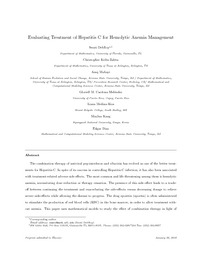| dc.contributor.author | Kribs, Christopher | |
| dc.contributor.author | DebRoy, Swati | |
| dc.contributor.author | Mubayi, Anuj | |
| dc.contributor.author | Cardona-Melendez, Gloriell M. | |
| dc.contributor.author | Medina-Rios, Liana | |
| dc.contributor.author | Kang, MinJun | |
| dc.contributor.author | Diaz, Edgar | |
| dc.date.accessioned | 2016-05-19T14:08:29Z | |
| dc.date.available | 2016-05-19T14:08:29Z | |
| dc.date.issued | 2010 | |
| dc.identifier.citation | Published in Mathematical Biosciences 225(2):141-155, June 2010 | en_US |
| dc.identifier.uri | http://hdl.handle.net/10106/25667 | |
| dc.description | Author's final draft after peer review, also known as a post print. | en_US |
| dc.description.abstract | The combination therapy of antiviral peg-interferon and ribavirin has evolved as one of the better treatments for Hepatitis-C. In spite of its success in controlling Hepatitis-C infection, it has also been associated with treatment-related adverse side effects. The most common and life threatening among them is hemolytic anemia, necessitating dose reduction or therapy cessation. The presence of this side effect leads to a trade-off between continuing the treatment and exacerbating the side-effects versus decreasing dosage to relieve severe side-effects while allowing the disease to progress. The drug epoietin (epoetin) is often administered
to stimulate the production of red blood cells (RBC) in the bone marrow, in order to allow treatment with-out anemia. This paper uses mathematical models to study the effect of combination therapy in light of anemia. In order to achieve this we introduce RBC concentration and amount of drug in the body as state variables in the usual immunological virus infection model. Analysis of this model provides a quantification of the amount of drug a body can tolerate without succumbing to hemolytic anemia. Indirect estimation of parameters allow us to calculate the necessary increment in RBC production to be 2:3 times the patient's original RBC production rate to sustain the entire course of treatment without encountering anemia in a sensitive patient. | en_US |
| dc.language.iso | en_US | en_US |
| dc.publisher | Elsevier | en_US |
| dc.subject | Hepatitis-C | en_US |
| dc.subject | HCV | en_US |
| dc.subject | Ribavirin | en_US |
| dc.subject | Interferon | en_US |
| dc.subject | Epoietin | en_US |
| dc.subject | Anemia | en_US |
| dc.subject | Hemolytic anemia | en_US |
| dc.subject | Mathematical modeling | en_US |
| dc.title | Evaluating treatment of Hepatitis C for hemolytic anemia management | en_US |
| dc.type | Article | en_US |
| dc.publisher.department | Department of Mathematics, University of Texas at Arlington | |
| dc.identifier.externalLinkDescription | The original publication is available at Article DOI | |
| dc.identifier.doi | http://dx.doi:10.1016/j.mbs.2010.02.005 | |

